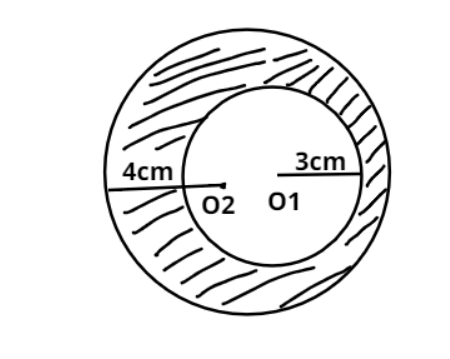
From a circular sheet of radius 4 cm, a circle of radius 3 cm is removed. Find the area of the remaining sheet. Take $\left( {\pi = 3.14} \right)$
Answer
607.2k+ views
Hint – In this question from the main circular sheet of radius 4 cm, a smaller circle of radius 3 cm is removed. So using the basic formula for area of circle, we can easily remove the smaller circular area from the larger circular area. This concept will give us the required remaining area.
Complete step-by-step answer:

Area of the circle of radius r is given as ${\text{A = }}\pi {r^2}$……………………. (1)
Now the radius of the larger circle centered at O2 is having radius r1=4cm……………. (2)
The radius of the smaller circle that is being removed from the larger circle is centered at O1 and has the radius r2=3cm……………………. (3)
Now putting the values in equation (1)
Area of larger circle centered at 02,
${{\text{A}}_2} = \pi {\left( 4 \right)^2} = 16\pi {\text{c}}{{\text{m}}^2}$…………………………… (4)
Now putting the values in equation (1) again
The area of smaller circle centered at O1,
${{\text{A}}_1} = \pi {\left( 3 \right)^2} = 9\pi {\text{c}}{{\text{m}}^2}$……………………… (5)
Now the required remaining area which is shaded in diagram is equal to the difference of larger circle centered at 02 and the area of smaller circle centered at O1.
Thus using equation (4) and (5) we can say that
$
{\text{Area req = 16}}\pi {\text{ - 9}}\pi \\
\Rightarrow 7\pi \\
$
Using $\pi = 3.14$ we get
Area required = $7 \times 3.14 = 21.98{\text{c}}{{\text{m}}^2}$
Note – Whenever we face such types of problems the key concept is to think of the diagrammatic representation using the data provided in the problem. This will give you the actual understanding about which area has to be removed from which area in order to reach the required area.
Complete step-by-step answer:

Area of the circle of radius r is given as ${\text{A = }}\pi {r^2}$……………………. (1)
Now the radius of the larger circle centered at O2 is having radius r1=4cm……………. (2)
The radius of the smaller circle that is being removed from the larger circle is centered at O1 and has the radius r2=3cm……………………. (3)
Now putting the values in equation (1)
Area of larger circle centered at 02,
${{\text{A}}_2} = \pi {\left( 4 \right)^2} = 16\pi {\text{c}}{{\text{m}}^2}$…………………………… (4)
Now putting the values in equation (1) again
The area of smaller circle centered at O1,
${{\text{A}}_1} = \pi {\left( 3 \right)^2} = 9\pi {\text{c}}{{\text{m}}^2}$……………………… (5)
Now the required remaining area which is shaded in diagram is equal to the difference of larger circle centered at 02 and the area of smaller circle centered at O1.
Thus using equation (4) and (5) we can say that
$
{\text{Area req = 16}}\pi {\text{ - 9}}\pi \\
\Rightarrow 7\pi \\
$
Using $\pi = 3.14$ we get
Area required = $7 \times 3.14 = 21.98{\text{c}}{{\text{m}}^2}$
Note – Whenever we face such types of problems the key concept is to think of the diagrammatic representation using the data provided in the problem. This will give you the actual understanding about which area has to be removed from which area in order to reach the required area.
Recently Updated Pages
Two men on either side of the cliff 90m height observe class 10 maths CBSE

What happens to glucose which enters nephron along class 10 biology CBSE

Cutting of the Chinese melon means A The business and class 10 social science CBSE

Write a dialogue with at least ten utterances between class 10 english CBSE

Show an aquatic food chain using the following organisms class 10 biology CBSE

A circle is inscribed in an equilateral triangle and class 10 maths CBSE

Trending doubts
Why is there a time difference of about 5 hours between class 10 social science CBSE

Write a letter to the principal requesting him to grant class 10 english CBSE

What is the median of the first 10 natural numbers class 10 maths CBSE

The Equation xxx + 2 is Satisfied when x is Equal to Class 10 Maths

Which of the following does not have a fundamental class 10 physics CBSE

State and prove converse of BPT Basic Proportionality class 10 maths CBSE




